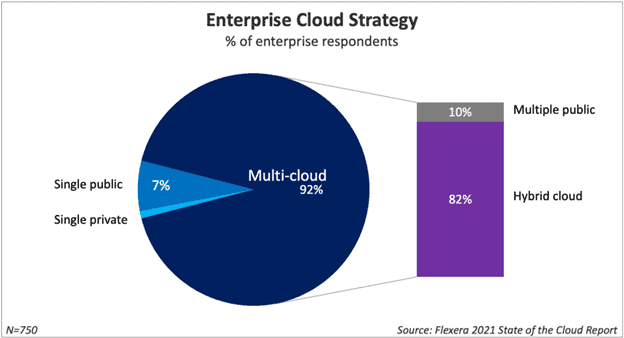Cloud computing is becoming mainstream, as pandemic-era business disruptions and remote work push more organisations to speed up their digital transformation.
But while cloud adoption is on the agenda for most enterprises and government agencies, not all are fully committed to a complete migration. As a 2020 study showed, about one-third of the organisations polled indicated that they are not yet prepared to be “all” or “mostly” in the cloud .
This hesitation to optimise their cloud presence may be due to various misconceptions regarding cloud computing. Here, we debunk five common myths and shed light on how using the right Cloud Management Platform (CMP) can maximise the cloud’s benefits.
Myth 1: Migrating is a long, arduous process
Some organisations may be under the false impression that it takes months – even years – of painstaking effort to plan and execute a cloud migration. In reality, data and system migration can be an automated process conducted in the background over just a few weeks.
There is little disruption to your daily activities – provided you harness the right tools to identify the optimal migration approach for each application. Conducting an automated discovery of your organisation’s inventory and applications, gives you full visibility of which applications are cloud-ready and which are not. It guides your organisation in reviewing and validating the extent of cloud dependency for each application, while proposing suitable approaches for modernising applications and creating blueprints for deployment.
Myth 2: The cloud is an all-or-nothing proposition
Some organisations are reluctant to take the first step because they think cloud migration has to be “all or nothing” – all their legacy applications must be upgraded and cloud-ready before they can start migrating. They may also delay because of data security fears.
What they need to understand is that not every piece of data has to be put on the cloud. Highly-sensitive data can be kept on-premise or on private clouds, and more than 80 percent of organisations actually adopt a hybrid cloud strategy using a combination of public cloud hosting services and private cloud infrastructure. With the right CMP, not only does it provide both options but also offers ease of management through a single pane of view across multiple cloud-hosting services.
Myth 3: Cloud migration unlocks instant cost savings
Cloud computing is often touted as a means to save money. Indeed, some organisations can save 30 to 50 percent by moving their applications to a cloud.
However, it would be unrealistic to expect cloud migrations to reap instant, significant cost reductions. The broader benefits of cloud include greater agility, allowing the enterprise to scale up and scale out more easily.
Moving to the cloud also allows for greater ease of business expansion, which might incur higher operational costs in the long run. This is why instead of focusing on cost savings, we strongly advocate placing the attention on cost optimisation to achieve business goals and objectives, reducing the tendency to waste cloud spend. One study found that 27 percent is wasted by the organisation itself – if it does not conduct regular reviews to optimise cloud resource utilisation.
Hence, it is critical to use a right CMP to help you manage costs and budgets to prevent overspending. It can automate discovery of new cloud workloads and provide right-sizing recommendations for them, while gathering resource utilisation insights across multiple cloud platforms.
Myth 4: Security is guaranteed on cloud
The majority of cloud users – 85 percent of respondents in a Google study – feel that cloud infrastructure is more secure than on-premise systems. Their confidence in the security of the cloud is indeed warranted, but this does not mean that users should lower their guard about the security of data kept within the cloud. Afterall, 99 percent of cloud security breaches are not the fault of the cloud provider, but of the users who failed to manage the controls used to protect an organisation’s data.
Organisations are responsible for enforcing security policies and risk acceptance for data stored in the cloud, and often need to add third-party security products to bolster their defence against data hacking, which exposes themselves to potentially higher risks.
Harness a CMP with robust security features provides services like monitoring and enforcing of Governance, Risk and Compliance (GRC), Data Loss Protection (DLP) and Database Access Monitoring (DAM) to meet organisations’ security needs. It also helps organisations to conform to Data Regulations and Compliance through its Polymorphed OS for Malware and Zero-Day Vulnerabilities Prevention.
Myth 5: One cloud strategy or vendor is all you need
Relying on just one cloud provider exposes you to the risks of a single point of failure if that provider suffers service disruptions. It is imperative that your mission- and business-critical applications are hosted across multiple cloud providers. More than 90 percent of organisations already adopt such a strategy, as this diagram shows:

Flexera 2021 Report – Enterprise Cloud Strategy
To ensure your organisation remains agile in multi-cloud adoption, using a powerful CMP tool helps you to plan for operational resilience and manage multiple cloud platforms more easily.
The solution to cloud journey needs: AGIL Cloud Management Platform
Embarking on the journey to the cloud entails a lot of complexities and regulations. Eliminate all these worries with AGIL Cloud Management Platform (CMP), which is able to assist you in gaining visibility, achieving agility and scalability while modernising processes and workflows, prepping your organisation towards seamless cloud transformation.
Enjoy a full spectrum of end-to-end cloud managed services and professional services with the latest security controls from ST Engineering.
To learn more, visit www.stengg.com/cloud












